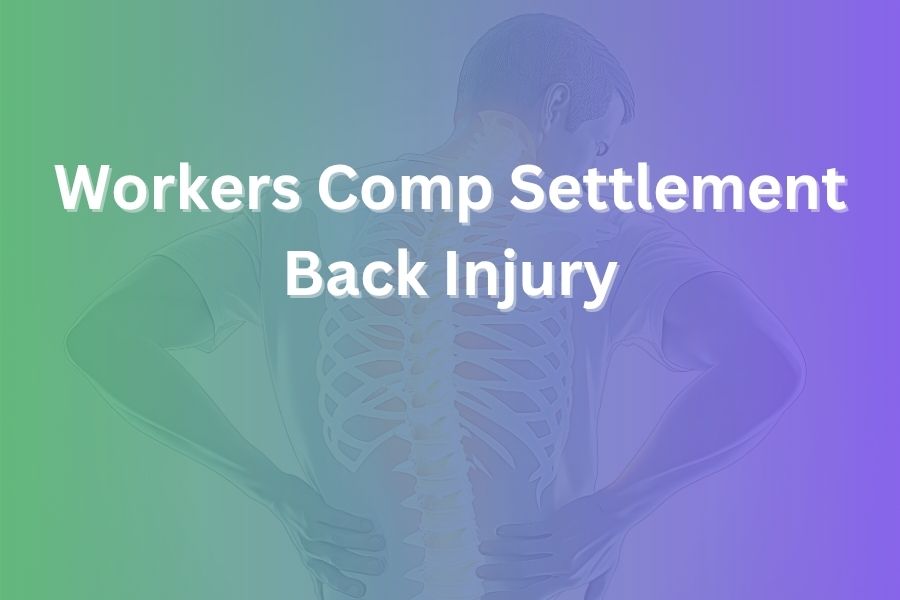If you’ve suffered a back injury while on the job, you deserve clarity, fair compensation, and a strong strategy to protect your rights. With 30 years of experience in this niche, I will walk you through the entire process—from how settlements work to what influences the amount you might receive.
In this article you will learn how back injury settlements under workers’ comp are calculated, what factors raise or lower the value, what typical settlement ranges are, and how to navigate the system effectively.
Understanding Workers’ Compensation for Back Injuries
When you injure your back at work, the system of Workers’ Compensation is designed to help cover your medical treatment, lost wages, and other related losses without you having to sue your employer. It is a “no-fault” system in most U.S. states: meaning you don’t need to prove employer negligence, only that your injury arose out of and in the course of employment.
Back injuries are among the most common and complex of workplace injuries. According to one study, back injuries ranked second in accepted claims in a particular state’s data set. Injuries ranged from strains and sprains to herniated discs and spinal cord damage.
Since the back is central to movement, lifting, bending, twisting and general daily work tasks, a back injury can have prolonged effects on your lifestyle, work capacity and long-term health. That complexity directly influences your settlement.
Common Types of Workplace Back Injuries
- Muscle strain or sprain from lifting or over-exertion
• Herniated or bulging disc pressing on nerves
• Spinal fractures or serious trauma from falls
• Chronic back conditions triggered or worsened by work duties
• Spinal cord injury or “failed back syndrome” where surgery fails to resolve symptoms
Whether it’s a sudden event (slip/trip/fall, heavy lifting) or accumulated trauma (repetitive bending, lifting) your work-related back injury must be well-documented for the compensation process to move smoothly.
What Does a Workers’ Comp Back Injury Settlement Cover?
A settlement for a back injury under workers’ comp may include:
• Past and future medical treatment costs (surgeries, therapy, medications)
• Indemnity or lost wage benefits (pay for time off work)
• Permanent impairment benefits if you have lasting restrictions
• Vocational rehabilitation if you are unable to return to your prior job
• Structured payment options or lump-sum settlement
It’s essential to understand that the settlement is not a fixed formula; it depends on your injury severity, treatment, future work capacity and state law.
Typical Settlement Amounts for Back Injuries
Let’s look at recent data so you can gauge the range you might face.
Some sources report average settlements for a back injury approximately $25,000-$30,000 in specific states.
Other data show broader ranges. For example, lower back injuries average around $39,300 and upper back injuries around $35,400 in one data set.
In more complex cases – surgery required, permanent disability, multiple body parts involved – settlements can rise dramatically: from $125,000 up to $500,000 or more.
A firm survey released in 2025 cited an average back injury settlement of about $67,500 – but emphasised the case-specific nature of each claim.
Also, insurer cost data for back injury claims averaged about $37,000 for lower back and $33,000 for upper back injuries – though those figures do not necessarily reflect what a claimant receives.
Understanding these ranges helps you set realistic expectations, but you must emphasise your unique facts.
Key Factors Influencing Your Settlement Value
Here’s where you, as a claimant, really need to focus. These factors determine whether you’ll land toward the lower end of the range or potentially much higher.
Severity of the Injury
The worse the injury (herniated disc, spinal fusion, nerve damage) the higher the settlement. Simple strains will pay far less.
Medical Treatment Required
If you need surgery or long-term therapy, the costs are higher, and the settlement will reflect that.
Time Off Work / Wage Loss
If you missed significant time or can’t return to your prior job, your wage loss and future earning capacity weigh heavily.
Permanent Impairment or Disability
If you end up with permanent restrictions or cannot do your former job, that raises value. For example, “failed back syndrome” claims often run very high.
Your Age and Work History
An older worker who can’t retrain may receive more than a younger person with a better chance to return to full duty.
Occupation and Job Demands
A labourer with heavy lifting duties will get higher compensation than an office worker with limited duties because the back injury affects future work capacity differently.
State Laws and Settlement Options
Different states allow lump‐sum settlements, structured payments, or have different maximums and rules. Settlement ability may depend on workers’ comp board approval.
Claim Documentation and Legal Representation
A well-documented claim supported by medical records, clear causation to the job, and an attorney can significantly improve your outcomes. A poorly documented claim with weak causation may settle for much less.
When a Settlement Is the Right Choice
You might wonder: when is it better to settle rather than continue benefits? Here are reasons to consider a settlement:
• Your medical condition is stable and future care costs are predictable
• You prefer a lump sum rather than continuing weekly benefits
• You leave the job or cannot return to your pre-injury work
• You want to close the case and avoid future treatment disputes
• You have legal advice indicating a fair value and you can secure proper protections (for example for future medical costs)
However, you must ensure that future medical costs and wage loss are accurately estimated before you settle. Because once you accept a lump sum, you may forfeit right to future benefits unless the settlement allows open medical or structured payments.
How to Maximise Your Settlement Value
As someone with decades in this field, I recommend these steps:
• Report your injury immediately and get medical treatment.
• Keep all medical records, therapy notes, imaging results, and work restrictions.
• Follow the doctor’s treatment plan and keep copies of invoices/expenses.
• Document your lost wages, job changes, and future limitations.
• Consult an experienced workers’ comp attorney before signing any settlement offer.
• Make sure the settlement includes future medical care if needed (open-ended medical).
• Don’t rush into a lump-sum settlement without knowing your future needs.
• Check state law for structured settlement rules, maximums, and your rights.
• If you must settle, ensure the agreement includes proper language protecting you from future claims and sets aside future medical obligations.
What to Expect During the Settlement Process
You will typically move through these stages:
- Injury and reporting: You get injured, report to employer, get treatment.
- Claim acceptance: The workers’ comp insurer or board accepts the claim, you receive medical and lost wage benefits.
- Medical treatment phase: You receive care, doctor determines your status, and sometimes assigns an impairment rating.
- Negotiation: Once your condition stabilises or you reach maximum medical improvement, settlement negotiations may start.
- Evaluation of future needs: You and your attorney estimate future medical costs, lost earning capacity, risk of re-injury.
- Settlement agreement: Offer is made, you agree (often with attorney), board approves (if required), you receive lump-sum or structured payment.
- Closure: Benefits cease except as otherwise agreed (for example open medical or lifetime weekly payments).
Common Mistakes to Avoid
- Settling too early before you know your full future medical needs.
• Accepting the first offer without comparison or legal advice.
• Failing to account for future wage loss and job change inefficiencies.
• Not including open medical benefits or future care protections.
• Ignoring that your ability to perform your previous job may be permanently impaired.
• Missing deadlines to dispute or appeal a settlement offer.
Realistic Example Scenarios
- A warehouse worker lifts heavy boxes, suffers a lower back herniation, requires surgery, and cannot return to heavy lifting duties. His settlement may fall in the $100,000-$300,000 or more range depending on state and severity.
• An office worker mildly strains his upper back, attends physical therapy, returns to light duty, and has minimal impairment. Settlement may be around $20,000-$30,000.
• A truck driver loses his job after back surgery, cannot drive again, and has future medical needs. Settlement may reach $250,000-$500,000+.
What Recent Data Suggests (2025 Update)
Recent estimates show the average back injury settlement at around $67,500, highlighting the mid-point of many non-catastrophic claims. But data also indicates catastrophic claims – major spinal surgery, permanent disability – can exceed $500,000. Employees must understand the wide spread and granular nature of their own claim.
State-by-state differences matter. In California, average settlement for back injuries with moderate severity is about $23,600 in some data. In other states with higher costs and greater disability exposure, the numbers are higher.
Insurance data puts the insurer cost for a lower back injury at about $37,000 and upper back injuries at $33,000; keep in mind insurer cost does not equal your take-home settlement.
Your Action Plan – Step by Step
- Immediately report the injury to your employer and get medical treatment.
- Make sure your treating doctor links the injury to your job duties in writing.
- Track all medical expenses, therapy sessions, time off work and job limitations.
- Consult an experienced workers’ compensation attorney promptly.
- Don’t accept a settlement without fully understanding future treatment, work capacity, and impairment.
- Review the settlement offer carefully; ask whether it includes future medical or only past costs.
- If you settle, make sure you understand whether it’s a lump sum or structured payment, whether medical benefits remain open, and whether any tax implications or Medicare set-aside considerations apply.
- Keep copies of all documentation and the final settlement agreement for your records.
- Continue to monitor any ongoing symptoms or additional medical issues tied to your back injury – because new costs may otherwise be excluded.
- If your condition worsens later, you may regret settling too early without adequate future protection.
Conclusion
If you’ve sustained a back injury at work, you’re dealing with more than just pain: you’re facing future limitations, medical costs, lost wages and possibly permanent impairment. Workers’ compensation settlement offers exist to address these consequences. With decades of experience, I’ve seen that a carefully handled back injury claim can lead to a fair outcome, but only if you understand the variables and act strategically. Use the data and guidance above as your foundation, treat your claim as one of the most important financial decisions you’ll make, and work with trusted professionals to ensure you get the compensation you truly deserve.




